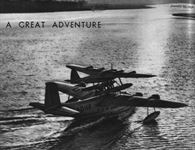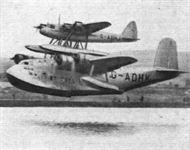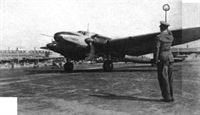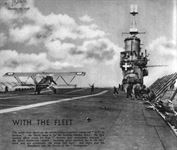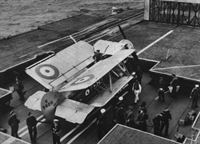Фотографии
-
Регистрационный номер: VH-UZH WHAT AUSTRALIA BUYS: The first Douglas D.C.3 to be put into Australian service flying over the city of Melbourne. The machine is named Kurana and is used by Airlines of Australia on the Brisbane-Sydney service.
Самолёты на фотографии: Douglas DC-3 / C-47 Skytrain/С-53 Skytrooper / Dakota - США - 1935
-
A Douglas DC-3 - actually the first to be delivered to Swissair.
Самолёты на фотографии: Douglas DC-3 / C-47 Skytrain/С-53 Skytrooper / Dakota - США - 1935
-
A striking view of the Curtiss P-36 single-seater ordered in quantity for the U.S. Army Air Corps. It is a clean design to the modern formula, but the undercarriage, which twists when retracting (as on the Miles Kestrel Trainer), gives rise to two excrescences.
Самолёты на фотографии: Curtiss Hawk 75 / P-36 / Mohawk - США - 1935
-
The eleven bridges of the Seine, the gardens of the Tuilleries, the Place de la Concorde are taken in at a glance by French bomberpilots parading their Hispano-powered Potez 54's over the heart of Paris.
Самолёты на фотографии: Potez Potez 54 - Франция - 1933
-
The Industrial areas are aesthetically unattractive but abound in vulnerable targets.
Самолёты на фотографии: Potez Potez 54 - Франция - 1933
-
NIGHTMARE: Most of us have occasionally gazed pensively at a wing tip and wondered horribly what we should feel like if it suddenly disappeared. This Japanese fighter (apparently a Mitsubishi Karigane) was brought safely back to its base with half of its port wing shot away. The photograph appears to be quite unfaked and the starboard aileron can, in the original, be seen to be pulled right up to hold the machine level in this condition.
Самолёты на фотографии: Mitsubishi A5M / Ki.18 - Япония - 1935
-
Регистрационный номер: G-ADHJ [3], G-ADHK [3] Самолёты на фотографии: Short Mayo Composite (S.20 Mercury and S.21 Maia) - Великобритания - 1938
-
Регистрационный номер: G-ADHJ [3], G-ADHK [3] TWO FIRSTS: The Short Mayo composite just free of the Medway on its first flight - Messrs. Lankester Parker and H. L. Piper in dual charge. This historically important first flight was followed by another, that of the Ensign, a few days later, at Hamble, Southampton.
Самолёты на фотографии: Short Mayo Composite (S.20 Mercury and S.21 Maia) - Великобритания - 1938
-
Регистрационный номер: G-ADHJ [3], G-ADHK [3] After minor modifications to details, the Mayo' Composite combination ("Maia" and "Mercury") has had its aerial baptism. On Wednesday of last week Capt. Lankester Parker had "Maia," with her burden, "on the step" and the first take-off, followed by a faultless ten-minute flight, was achieved on Thursday.
Самолёты на фотографии: Short Mayo Composite (S.20 Mercury and S.21 Maia) - Великобритания - 1938
-
A Consolidated PBY patrol bomber (two 850 h.p. Pratt and Whitney Twin Wasps) of the U.S. Navy. This machine is one of the most successful of its type ever built.
Самолёты на фотографии: Consolidated PBY Catalina - США - 1935
-
Регистрационный номер: D-AXAV Signalling-out an He.111 with an indicator of the type used on railways. Note the official's armament.
“An efficient member of the tarmac staff ... might well be supplied, as is the fairly common practice abroad, with a suitable flag or light metal disc on a wooden handle, clearly marked with the letter 'C,' indicating Control."Самолёты на фотографии: Heinkel He-111 - Германия - 1935
-
REARMAMENT: Changing the barrel of a Browning machine gun in a Boeing single-seater pursuit monoplane of the U.S. Army Air Corps. A portion of an ammunition belt may be seen draped over the side of the cockpit. Browning guns, in adapted form, are standard equipment in our own Royal Air Force.
Самолёты на фотографии: Boeing P-26 Peashooter - США - 1932
-
The wintry scene shows French Bloch bombers at Orly after manoeuvres abroad.
Самолёты на фотографии: Bloch MB.200 - Франция - 1933
-
First produced in 1913, the Avro 504 became and remained the standard training machine of thr R.A.F. until a few years ago. The engine of the original machine was an 80 h.p. Gnome rotary.
Самолёты на фотографии: Avro Avro 504 - Великобритания - 1913
-
The family tree: These six sketches ot early types show quite clearly the natural evolution which culminated in the 504, the type which laid the foundation of the greatness of the house of Avro
Самолёты на фотографии: Avro Avro 504 - Великобритания - 1913Avro Triplane I - III - Великобритания - 1909Avro Triplane IV - Великобритания - 1910Avro Type D - Великобритания - 1911Avro Type E / 500 - Великобритания - 1912
-
Avro productions of the war period. These side elevations, all to a uniform scale, are reproduced from Flight of March 20, 1919.
Самолёты на фотографии: Avro Avro 504 - Великобритания - 1913Avro Avro 530 - Великобритания - 1917Avro Baby / Type 534 - Великобритания - 1919Avro Manchester / Type 533 - Великобритания - 1918Avro Pike / Type 523 / Type 529 - Великобритания - 1916Avro Spider / Type 531 - Великобритания - 1918
-
Flying in 1908-09: “A.V.” piloting one of his early triplanes with J.A.P. engine. The contemplated duration may be gauged from the size of the streamline petrol tank
Самолёты на фотографии: Avro Triplane I - III - Великобритания - 1909
-
Регистрационный номер: G-ADSR G-ADSR: Last Monday morning the huge Armstrong Whitworth Ensign, first of the new 42-seaters for Imperial Airways, made her first flight, Flt. Lt. C. K. Turner-Hughes and F/O. Eric Greenwood taking her off from the A.S.T. Aerodrome, at Hamble, for an uneventful and satisfactory 15-minute flight. The machine, which is of 123ft. span, has four Armstrong Siddeley 800 h.p. 14-cylinder Tiger IXs.
Самолёты на фотографии: Armstrong Whitworth Ensign / A.W.27 - Великобритания - 1938
-
Seen as a prototype at last year’s Milan show, the military version of the three-engined Cant Z. 506.B. is a low-wing mono-seaplane said to be capable of about 240 m.p.h. (Inset) Mario Stoppani.
Самолёты на фотографии: CANT Z.506B/S Airone - Италия - 1937
-
VICKERS WELLESLEY medium bombers, complete with bomb carriers, awaiting the arrival of Service pilots to ferry them to depots or squadrons
Самолёты на фотографии: Vickers Wellesley - Великобритания - 1935
-
DUCAL DIGNITY: The first production-type Vickers Wellington I <...> bomber built on the geodetic principle and powered with two Bristol Pegasus XVII radials with two-speed blowers. The transparency of the <...>nd tail turret roofs in this view gives a false impression of marring the fine lines of the fuselage which, incidentally, <...> revised since the prototype appeared.
Самолёты на фотографии: Vickers Wellington / Type 271 - Великобритания - 1936
-
Регистрационный номер: L4212 GEODETIC TWIN: The production-type Vickers Wellington I (two Pegasus XVII) built, like the Wellesley, on the geodetic principle. Part of the construction can be glimpsed through the Perspex of the bomb-aimer's window.
Самолёты на фотографии: Vickers Wellington / Type 271 - Великобритания - 1936
-
GEODETIC BOMBER: The production-type Vickers Wellington I medium bomber awaiting tests at Weybridge.
Самолёты на фотографии: Vickers Wellington / Type 271 - Великобритания - 1936
-
KIT, or the White Man's Burden: A story without words from N<...> regalia shown, including parachute, is said to weigh 58 3/4 lb.
Самолёты на фотографии: Gloster Gauntlet - Великобритания - 1929
-
The white cross shows on the carrier's superstructure, signifying "O.K. to land on"; the Shark noses in for the landing, touches down; the deck landing officer raises his flags ("Arrester gear successfully engaged"); the Shark decelerates rapidly; handling crews shepherd her to the lift; latch pins are withdrawn, the wings fold back; and down goes the Blackburn into the bowels of the "Courageous."
Самолёты на фотографии: Blackburn Shark / B-6 - Великобритания - 1933
-
Регистрационный номер: K5620 Самолёты на фотографии: Blackburn Shark / B-6 - Великобритания - 1933
-
SO FAR, SO GOOD: The five London flying boats of No.204 (G.R.) Squadron on the River Hughli below Calcutta. They are on a cruise to Australia.
Самолёты на фотографии: Saunders-Roe London / A.27 - Великобритания - 1934
-
The new Consolidated XPB2Y-1 patrol bomber (four Twin Wasps) recently completed. This machine is in competition with a Sikorsky boat with similar characteristics.
Самолёты на фотографии: Consolidated PB2Y Coronado - США - 1937
-
LORD HUNTINGFORD, Governor of Victoria, in an Anson of the City of Melbourne Squadron, of which he is the Honorary Air Commodore.
Самолёты на фотографии: Avro Anson / Type 652 - Великобритания - 1935
-
A formation of Avro "Ansons" (350 h.p. Siddeley "Cheetahs") belonging to the Royal Australian Air Force, flying over Sydney, N.S.W.
Anson reconnaissance-bombers of the Royal Australian Air Force in impressive array over Sydney. Combining economy with performance (a top speed of nearly 190 m.p.h. is available on about 700 h.p. delivered by two Siddeley Cheetahs), this British general-purpose type is an attractive proposition for air arms with limited financial resources.Самолёты на фотографии: Avro Anson / Type 652 - Великобритания - 1935
-
The latest Avro type, the Anson general reconnaissance machine, has a speed of 188 m.p.h. when fitted with two Siddeley Cheetah IX engines of 310 h.p. each.
Самолёты на фотографии: Avro Anson / Type 652 - Великобритания - 1935
-
Medium-sized type used in the efficiency comparisons - the D.H.89.
Самолёты на фотографии: De Havilland Dragon Rapide / Dominie / D.H.89 - Великобритания - 1934
-
Самолёты на фотографии: Douglas DC-1 / DC-2 / C-32 / C-39 - США - 1933
-
BLIND TRANSPORT: With the cockpit completely screened a T.W.A. pilot takes his regular blind-flying test (demanded every 90 days) under the eye of one of the line's chief pilots.
Самолёты на фотографии: Douglas DC-1 / DC-2 / C-32 / C-39 - США - 1933
-
Самолёты на фотографии: De Havilland Express Air Liner / D.H.86 - Великобритания - 1934
-
The instrumental equipment of one of the Monospars used at Farnborough for blind-approach experiments. The special millibar correction scale on the sensitive altimeter is interesting and it may be possible to read the notice above it which orders that two millibars should be added to the barometric pressure given. Two millibars are, in fact, equal to 60 feet at sea level. An altimeter-guided approach has its dangers.
Самолёты на фотографии: General Aircraft Monospar ST-25 Universal - Великобритания - 1935
-
Регистрационный номер: G-ADHM Two of the boats which made history last year - Caledonia and Clipper III - being hauled on to the slipway at Hythe (left). The former was commanded by Capt. Wilcockson and the latter by Capt. Gray on all the Atlantic trips.
Самолёты на фотографии: Short Empire / S.23 - Великобритания - 1936
-
A good example of modern aircraft radio installation - the very complete Marconi equipment in the Short Empire boat. A close-up of the sets with various parts uncovered for inspection. This installation comprises long and short wave two-way equipment with a rotating loop, which may be used either for obtaining bearings or for homing, and a self-contained generating station.
Самолёты на фотографии: Short Empire / S.23 - Великобритания - 1936
-
A good example of modern aircraft radio installation - the very complete Marconi equipment in the Short Empire boat. This installation comprises long and short wave two-way equipment with a rotating loop, which may be used either for obtaining bearings or for homing, and a self-contained generating station, part of which may be seen in the lower right-hand corner of the picture.
Самолёты на фотографии: Short Empire / S.23 - Великобритания - 1936
-
LIGHT TRANSPORT - 1938 MODEL: The new Potez 66 which is estimated to be capable of 200 m.p.h. with four 220 h.p. Renault 6Qs (Model 661) or 290 m.p.h. with the new Gnome Rhone 14M small-diameter radials (Model 662).
Самолёты на фотографии: Potez Potez 661 - Франция - 1937
-
FAR EASTERN TERMINAL: A Klemm 35 being refuelled at Singapore's new land-sea airport. Major Haerle, the pilot, was on his way from Berlin to Batavia.
Самолёты на фотографии: Klemm Kl.35 / Kl.106 - Германия - 1935
-
Регистрационный номер: I-LUCE, I-ESTE, I-ESTO THE FASTEST TRANSPORT: A revealing view of the Savoia Marchetti S.83 as ordered by Sabena and by transport concerns in Italy and Rumania. Powered with three Pegasus-type Alfas, the top speed, with a disposable load of 7,700 lb., is 263 m.p.h., making it the fastest standard transport in the world. The type is derived from the S.79 which holds a number of records for speed with load.
Самолёты на фотографии: Savoia-Marchetti / SIAI SM.83 - Италия - 1937
-
ECONOMICAL SPEED: The Valsts Elektrotechniska Fabrika J.12, for which Rollasons of Croydon are agents in this country. With an 80/90 Cirrus Minor engine this little two-seater cruises at 123 m.p.h. and has a maximum of 149 m.p.h. One or two minor modifications are being made to the later production machines in order to bring them into line with British C. of A. requirements. Among other interesting features the J.12 has manually applied split flaps and differentially operated slotted ailerons.
Самолёты на фотографии: Irbitis, VEF I-11 / I-12 / I-17 - Латвия - 1936
-
Регистрационный номер: YR-AHA The special Bellanca built for the Rumanian Captain Alexis Papana for a transatlantic flight. The nose engine is a Fairchild Ranger inverted vee and the outboard units are six-in-line Menascos.
Самолёты на фотографии: Bellanca 28-92 - США - 1937
-
Curtiss A-18 attack machines (two Cyclone Gs) in service test with the U.S. Army Air Corps. These machines are intended to replace the single-engined machines now in use.
Самолёты на фотографии: Curtiss A-14 / A-18 Shrike - США - 1935
-
A Curtiss A-18 twin-Cyclone attack machine, a shapely two-seater which carries a big armament load.
Самолёты на фотографии: Curtiss A-14 / A-18 Shrike - США - 1935
-
CANADIAN TERMINUS: Sea Island Airport, Vancouver, B.C., where the trans-Canada service has its western terminus. The administration building is on the right and the new radio station is on the left. In the foreground is Canadian Airways’ first Lockheed Electra used on the Vancouver-Seattle service.
Самолёты на фотографии: Lockheed Electra 10 - США - 1934
-
Регистрационный номер: G-AEPN, W9105 One of British Airways' Lockheed Electras.
Самолёты на фотографии: Lockheed Electra 10 - США - 1934
-
Air Corps officials inspecting the Fowler flaps on the Lockheed 14 (or Sky Zephyr) transport.
Самолёты на фотографии: Lockheed Super Electra 14 - США - 1937
-
General arrangement of the Seversky Executive. The type is intended for specific duties - high-speed transport.
Самолёты на фотографии: Seversky SEV-2PA / AT-12 - США - 1937
-
Two of the boats which made history last year - Caledonia and Clipper III - being hauled on to the slipway at Hythe (left). The former was commanded by Capt. Wilcockson and the latter by Capt. Gray on all the Atlantic trips.
Самолёты на фотографии: Sikorsky S-42 Clipper - США - 1934
-
Регистрационный номер: CF-BEQ SEAPLANE CONVERSION: A Stinson SR-9D Reliant seaplane used in Canada by the Imperial Oil Company. The extra fin below the fuselage - to balance the effect of the floats which provide excessive side area ahead of the c.g. - is a noteworthy modification to the standard version of the machine. The actual and necessary size of the floats explains some of the difficulties involved in any conversion.
Самолёты на фотографии: Stinson Reliant - США - 1933
-
Регистрационный номер: G-AAXD Shoreham Airport; the photograph was taken when Horatius landed there during recent bad weather.
Самолёты на фотографии: Handley Page H.P.42 / H.P.45 - Великобритания - 1930
-
8,000 MILES ON 40 H.P. Mr. J. Clancy (shaking hands) and Mr. R. H. Julius welcomed back by Mr. Bridgeland, secretary of the Royal Australian Aero Club, from a remarkable 8,000-mile flight round Australia in a Taylor Cub (40 h.p. Continental) by far the lowest-powered of the few machines which have ever made the circuit. Starting from Sydney and flying in an anti-clockwise direction, they made excellent progress, their only difficulties arising from primitive aerodromes and from navigational problems of the kind encountered when flying over hundreds of miles of territory virtually barren of any landmark. Between Perth and Adelaide they followed the longest stretch of dead straight railroad in the world - 400 miles. The other snapshot above shows a typical stretch of the uninviting country over which the little machine flew. Mr. Julius is a partner in the firm of Julius Gardiner and Co., of Sydney, who are handling the Cub in Australia, following an introduction by Mr. “Bill” Shackleton when he was visiting America some time ago.
Самолёты на фотографии: Taylor Cub - США - 1931
-
General arrangement of the Abrams Explorer. The type is intended for specific duties - aerial survey.
Самолёты на фотографии: Abrams P-1 Explorer - США - 1937
-
Регистрационный номер: G-ACSS, K5084 The COMET EN NEGLIGEE: The D.H. Comet, shortly to be used by F.O. Clouston and Mr. Victor Ricketts for an attempt on the Australia record, photographed in the shops of Essex Aero Ltd., while being reconditioned before Clouston's recent Cape flight. In the foreground are some of the parts - nose fairings, engine nacelles, wing fillets and so forth made of F. A. Hughes’ Elektron AM.503 alloy, which, it is stated, has stood up excellently to all kinds of weather in the many parts of the world traversed by the Comet on her various high-speed flights; the mechanical reliability of these sheet parts has been equally good.
Самолёты на фотографии: De Havilland Comet / D.H.88 - Великобритания - 1934
-
Регистрационный номер: G-ACTS Quick and systematic handling of holiday passengers and joy-riders has been brought to a fine art by Portsmouth, Southsea and Isle of Wight Aviation. Their I.O.W. ferry has introduced thousands to flying.
The Portsmouth, Southsea and Isle of Wight Aviation Ltd. fleet at Portsmouth in 1937. Four Airspeed Couriers are lined up on the left and a Fox Moth and two Monospars stand behind them. The ST-10 G-ACTS won the 1934 King’s Cup Air Race. It was a prototype and never went into production, but served with PSIOW on the Ryde Ferry.Самолёты на фотографии: Airspeed Courier / AS.5 - Великобритания - 1933De Havilland Fox Moth / D.H.83 - Великобритания - 1932General Aircraft Monospar ST-4 - ST-12 - Великобритания - 1932
-
Early seaplane work: A 1911 biplane with 35 h.p. Green engine, flown by Commander Schwann at Barrow.
Commander Schwann's Avro, the first tractor seaplane to get off the water. In the photo, Sippe is in the cockpit.Самолёты на фотографии: Avro Type D - Великобритания - 1911
-
Регистрационный номер: G-ACNN MAKING READY: Private-owner and other types inside the big service hangar at Heston. This hangar will, in due course, be taken over by British Airways and another service shop erected elsewhere.
Самолёты на фотографии: De Havilland Leopard Moth / D.H.85 - Великобритания - 1933
-
Boeing YB-17 heavy bombers (four Wright Cyclone Gs) of the U.S. Army Air Corps fly past the Wright Memorial at Kitty Hawk, North Carolina, in commemoration of the Brothers’ flight
Самолёты на фотографии: Boeing B-17 Flying Fortress - США - 1935
-
Регистрационный номер: K3585 TROOPER-TANKER: The hose reel on the A.W.23 troop carrier now being used by Sir Alan Cobham for refuelling experiments on the South Coast. An Empire boat has already acted as refuellee.
Самолёты на фотографии: Armstrong Whitworth A.W.23 - Великобритания - 1935
-
Great Lakes dive bomber.
Самолёты на фотографии: Great Lakes BG-1 - США - 1933
-
With a little single-seat monoplane designed and built by himself, M. Tonya recently broke the world's altitude record for single seaters of less than 2 litres engine capacity. He reached a height of 16,240 ft with a 40 h.p. Train 4.T. engine. After taking this record M. Tonya at once took off with a co-pilot, M. Saboureault, on a two-seater machine, L’Aile Volante A.V.10 (shown), and reached a height of 22,965 ft. - a record for the class with a cylinder capacity of under 4 litres. The engine was a specially prepared 75 h.p. Pobjoy.
Самолёты на фотографии: Fauvel AV.10 - Франция - 1935
-
With a little single-seat monoplane designed and built by himself, M. Tonya recently broke the world's altitude record for single seaters of less than 2 litres engine capacity. He reached a height of 16,240 ft with a 40 h.p. Train 4.T. engine.
Самолёты на фотографии: Tonya monplane - Франция - 1937
-
1912 at Brooklands: The Avro 500 (50 h.p. Gnome rotary engine) from which was developed the 504. Mr. F. P. Raynham did a lot of flying on this machine.
Самолёты на фотографии: Avro Type E / 500 - Великобритания - 1912
-
Great Lakes dive bomber. It will be seen that the original version has been developed into an exceptionally clean biplane (photo) with a retractable undercarriage and a performance much superior with the same engine.
Самолёты на фотографии: Great Lakes XB2G - США - 1935
Статьи
- Flight
- Flight Advertisements






